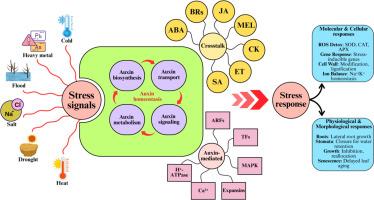生长素代谢和信号传导:整合植物非生物胁迫响应的独立机制和串扰
IF 6.8
Q1 PLANT SCIENCES
引用次数: 0
摘要
植物会遇到各种各样的非生物胁迫,这些胁迫会严重影响它们的生长、发育和生产力。作为不可移动的生物,植物依靠复杂的胁迫感知、信号和调节机制来适应和生存在具有挑战性的条件下。生长素是一种重要的植物生长调节剂,通过影响各种分子、生化和生理过程,在调节这些反应中起着核心作用。它通过多种生物合成途径合成,并通过代谢、转运和信号转导受到严格调控。生长素通过独特的、独立于其他激素的应激特异性机制直接控制应激反应,最近对个体应激条件下生长素调节基因表达和信号传导模块的研究支持了这一点。与此同时,生长素作为激素串音网络的中心整合者,与脱落酸(ABA)、油菜素内酯(BRs)、细胞分裂素(CK)、乙烯(ET)、茉莉酸(JA)、褪黑素(Mel)和水杨酸(SA)相互作用,微调适应性反应。本文从生长素的胁迫特异性、独立机制和非生物胁迫条件下激素串扰的综合功能两方面探讨了生长素的作用。通过阐明这些不同的调控框架,本文强调了生长素在提高植物抗逆性中的多方面作用,并探讨了提高抗逆性的潜在农业策略。本文章由计算机程序翻译,如有差异,请以英文原文为准。

Auxin metabolism and signaling: Integrating independent mechanisms and crosstalk in plant abiotic stress responses
Plants encounter various abiotic stresses that substantially impact their growth, development, and productivity. As immobile organisms, plants rely on sophisticated stress sensing, signaling, and regulation mechanisms to adapt and survive under challenging conditions. Auxin, a major plant growth regulator, plays a central role in modulating these responses by influencing various molecular, biochemical, and physiological processes. It is synthesized through multiple biosynthetic pathways and tightly regulated via metabolism, transport, and signal transduction. Auxin directly governs stress responses through distinct, stress-specific mechanisms that operate independently of other hormones, as supported by recent studies on auxin-regulated gene expression and signaling modules under individual stress conditions. In parallel, auxin acts as a central integrator in hormonal crosstalk networks, interacting with abscisic acid (ABA), brassinosteroids (BRs), cytokinin (CK), ethylene (ET), jasmonic acid (JA), melatonin (Mel), and salicylic acid (SA) to fine-tune adaptive responses. This review delves into the dual aspects of auxin's role by first analyzing its stress-specific, independent mechanisms and then exploring its integrative functions through hormonal crosstalk during abiotic stress conditions. By shedding light on these distinct regulatory frameworks, this review emphasizes auxin's multifaceted role in enhancing plant resilience and explores potential agricultural strategies for improving stress tolerance.
求助全文
通过发布文献求助,成功后即可免费获取论文全文。
去求助
来源期刊

Plant Stress
PLANT SCIENCES-
CiteScore
5.20
自引率
8.00%
发文量
76
审稿时长
63 days
期刊介绍:
The journal Plant Stress deals with plant (or other photoautotrophs, such as algae, cyanobacteria and lichens) responses to abiotic and biotic stress factors that can result in limited growth and productivity. Such responses can be analyzed and described at a physiological, biochemical and molecular level. Experimental approaches/technologies aiming to improve growth and productivity with a potential for downstream validation under stress conditions will also be considered. Both fundamental and applied research manuscripts are welcome, provided that clear mechanistic hypotheses are made and descriptive approaches are avoided. In addition, high-quality review articles will also be considered, provided they follow a critical approach and stimulate thought for future research avenues.
Plant Stress welcomes high-quality manuscripts related (but not limited) to interactions between plants and:
Lack of water (drought) and excess (flooding),
Salinity stress,
Elevated temperature and/or low temperature (chilling and freezing),
Hypoxia and/or anoxia,
Mineral nutrient excess and/or deficiency,
Heavy metals and/or metalloids,
Plant priming (chemical, biological, physiological, nanomaterial, biostimulant) approaches for improved stress protection,
Viral, phytoplasma, bacterial and fungal plant-pathogen interactions.
The journal welcomes basic and applied research articles, as well as review articles and short communications. All submitted manuscripts will be subject to a thorough peer-reviewing process.
 求助内容:
求助内容: 应助结果提醒方式:
应助结果提醒方式:


